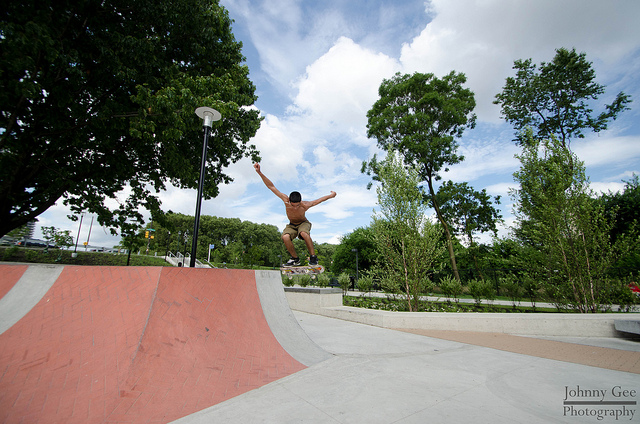
Skating at Paine’s Park. Photo © Johnny Gee Photography, licensed Creative Commons Attribution No-Derivatives.
Philly has long been a hot spot for skateboarding. For many years, skaters from New York, Boston, Los Angeles, and even overseas made the journey to Philadelphia’s landmark Love Park (officially JFK Plaza). They came to thrash on its ramps, granite ledges, and stairs in a prime setting smack in the center of urban Philadelphia. Featured in practically every skate magazine there is and frequented by many pro and semi-pro skaters, Love Park was internationally recognized, and Philly was even chosen to host the 2001-2002 ESPN X Games as a result. Despite many protests, the city closed Love Park to skaters in 2002 so that the suits on lunch breaks could eat in peace.And then the city government stepped in and ruined everything. In response to damage complaints and other alleged nuisances, one of Philadelphia’s major recreational assets and one of the things that made it so popular with youth came to an end. Despite many protests, the city closed Love Park to skaters in 2002 so that the suits on lunch breaks could eat in peace. Skaters were relegated to the only remaining large-scale skateboarding area in the city, FDR Park. Located on Pattison Avenue and Tuscany Drive at the park’s south end, it’s within walking (or rolling) distance to the Broad Street Subway Line. Philly’s skate culture lived on in the shade of the raised highway, I-95, above. Fishbowls, ramps, innovative skate structures, and a 30-foot half pipe make this skate park pretty impressive, but the location leaves something to be desired. It’s completely separate from the rest of the city, unlike prominent Love Park.After the closing of Love in 2002, the city donated a beautiful 2.5-acre plot of land along the Schuylkill River near the Art Museum to use for Paine’s Park, a new state-of-the art urban skate plaza. However, it was up to a small group of dedicated individuals to raise the $5 million needed to build the park. After over a decade in the works skaters were starting to lose hope that the park would ever open. In 2013 Paine’s Park finally broke ground. The multi-use plaza was designed to incorporate interesting skate-friendly surfaces with art and green space so that the general public can enjoy it as well. The park is a huge success and has revitalized skateboarding in Philadelphia. It represents a shift in the city’s perception of skateboarders from a public nuisance to valued members of the community. The momentum of Paine’s Park has also helped further the progress of a number of smaller parks being erected in neighborhoods throughout the city.
Excerpted from the Third Edition of Moon Philadelphia.